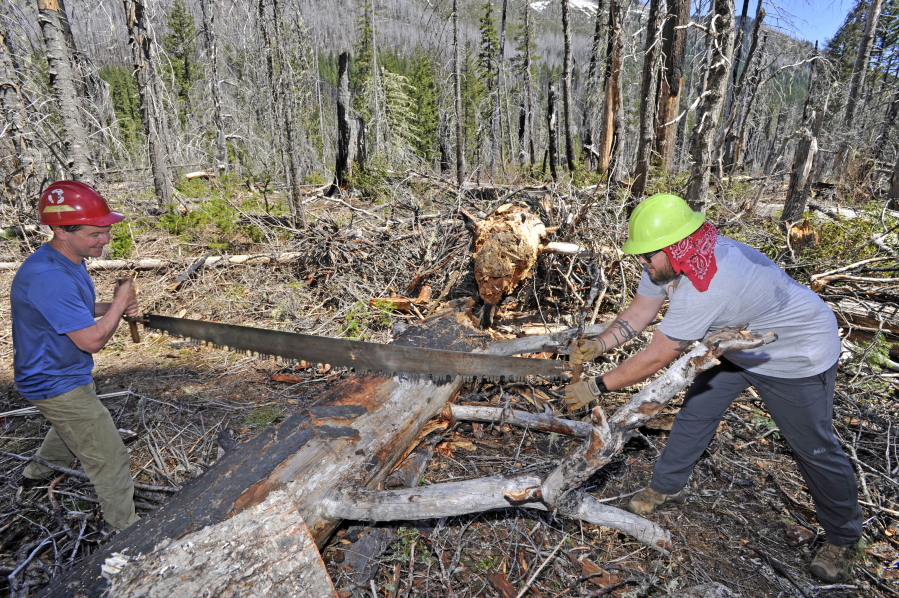MEDFORD, Ore. — The sharp teeth of the cross-cut saw carve like a file through the thick fir log to the rhythm of Jason Middleton and Aaron Babcock pushing and pulling this antique tool of the backwoods.
“We’d already be through it but we hit a knot,” Babcock says.
But the knot proves to be no match for the seasoned saw, and the split log sloughs into the Middle Fork Trail, where Gabe Howe joins the men in hauling the log away to make way on the trail.
That’s one down, 14,999 to go.
Babcock, Howe and other members of the Siskiyou Mountain Club are embarking on an ambitious task of reclaiming a historic 27-mile hiking loop through the Sky Lakes Wilderness Area in the southern Cascade Range of Oregon that is blocked with an estimated 15,000 blown-down trees, including thousands within 2008’s Middle Fork fire zone.
Three SMC crews will each log 10-day hitches in the wilderness area, armed only with cross-cut saws, axes and other hand tools, because chain saws and other mechanized tools are banned in federally designated wilderness areas.
They’ll be joined by volunteers as they work their way all summer from the Middle Fork Trailhead through the long loop created by a suite of other conjoining trails.
“I think it’s a reasonable goal, but there are features that are out of our control,” says Babcock, a SMC crew leader.
It’s all part of the nonprofit club’s credo of stepping into Southern Oregon’s backcountry to reclaim wilderness trails left impassable amid years of U.S. Forest Service maintenance backlogs, particularly those where a lack of post-wildfire work could see historic trails disappear.
“We don’t want to build new trails,” says Howe, the club’s founder and executive director. “We want to save one that’s been forsaken.”
‘Lollipops’
The loop begins at the Middle Fork Trail at the wilderness boundary east of Prospect. After 3 miles, it veers off into a 21-mile loop that piggybacks onto the Lake Alta, Seven Lakes, Pacific Crest, McKie Cabin and Halifax trails before rejoining the Middle Fork Trail for a retrace of the final three miles back to the trailhead.
These types of loop trails are called “lollipops” because they appear on maps like a round lollipop at the end of a stick. They are popular among hikers because starting and ending at one location makes for easier access, with no shuttle requirements.
These trails have existed for decades within the 113,849-acre wilderness area designated in 1984 — home to some of the more awesome features in the South Cascades.
A federal Environmental Protection Agency study in the early 1990s found lakes such as Alta possess some of the most chemically pure water on the planet. It’s also now the home range of gray wolf OR-7 and his Rogue Pack, the first known wolf pack in western Oregon since the 1930s and currently the only one in Oregon outside of the state’s northeast corner.
Years of wind storms have toppled live trees and dead ones, particularly within the wilderness portion where 2008’s Middle Rogue fire swept through nearly 18,000 acres of forest land.
“The acute challenge is the fire area,” Howe says. “There are so many downed trees that someone wouldn’t even be able to recognize where the trail is.”
Pair of grants
The project is funded through a $20,000 U.S. Forest Service grant and a $10,000 grant from the REI store in Medford, which gets $20,000 a year from its parent company to put toward projects store staff believe would benefit their patrons, says Middleton, the store’s sales manager.
The SMC did a similar reclamation project in southwest Oregon’s Kalmiopsis Wilderness that drew raves recently from Outside Magazine, and Howe says more work on existing trails will create attractive recreation opportunities in the backwoods.
“There’s a lot of potential to keep people recreating in Southern Oregon, like this trail,” Howe says. “There’s more here than the Shakespeare Festival and the Rogue River.
“Maybe every tree won’t be gone from this loop, but I think a reasonable person will be able to hike it after this summer,” Howe says.
Even if Howe and his crews get to all 15,000 downed trees, it doesn’t mean they would be done.
“We don’t cut and run, open the trail and walk away,” Howe says. “We’ll be back. This is stewardship.”



